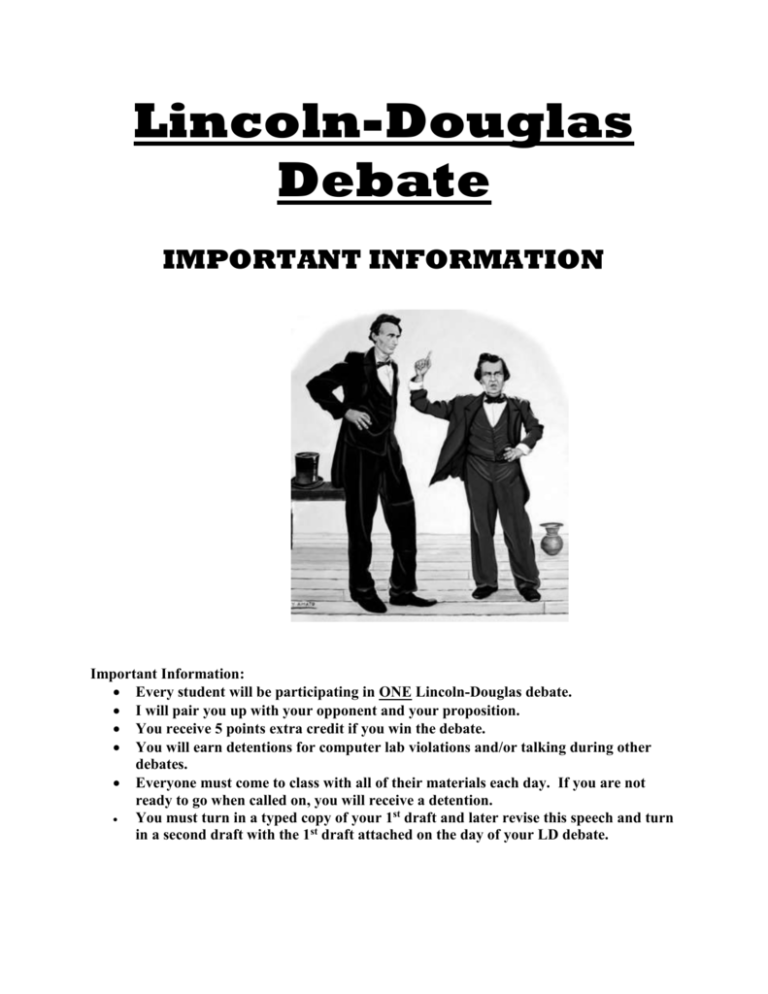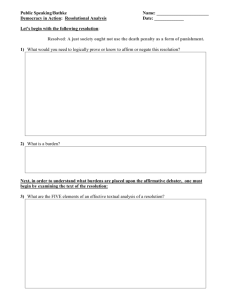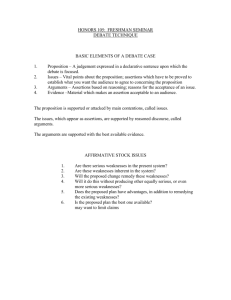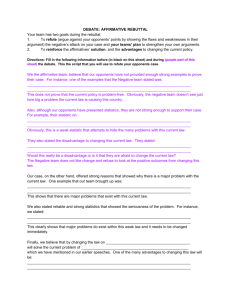Lincoln-Douglas Debate
advertisement

Lincoln-Douglas Debate IMPORTANT INFORMATION Important Information: Every student will be participating in ONE Lincoln-Douglas debate. I will pair you up with your opponent and your proposition. You receive 5 points extra credit if you win the debate. You will earn detentions for computer lab violations and/or talking during other debates. Everyone must come to class with all of their materials each day. If you are not ready to go when called on, you will receive a detention. You must turn in a typed copy of your 1st draft and later revise this speech and turn in a second draft with the 1st draft attached on the day of your LD debate. We base our decisions on our VALUES. Imagine it is a late Saturday night. You were out with your friends and are now driving home. You are almost past your curfew of 12:00am. You must make it home on time or else your strict parents will punish you, and you won’t be able to go to this concert of your favorite band next weekend. You are a few blocks away from your house. You get stopped by a red light – that infamous red light that always appears to be red when you arrive at it. No cars are in sight and rarely are at this time of night. As usual, the red light seems to be lasting forever. All you can think about is your mom and dad waiting up for you, ready to ground you for being out past your curfew and you not being able to go to that concert. Running the red light would probably get you home on time safely, but you risk getting a ticket or causing an accident. 1. What do YOU decide to do? (there’s no right/wrong answer) Wait for the red light to turn to green and risk coming home late, getting in trouble, and not being able to go to that concert. Run the red light in order to make it home and risk getting a ticket or even worse, getting in an accident. ______________________________________________________________________________ ______________________________________________________________________________ ______________________________________________________________________________ ______________________________________________________________________________ ______________________________________________________________________________ ______________________________________________________________________________ 2. On what value(s) do you base your decision? ______________________________________________________________________________ ______________________________________________________________________________ ______________________________________________________________________________ ______________________________________________________________________________ As the previous page hopefully proved, every individual’s values differ, and as a result, so do our decisions. Let’s consider what the following groups of people might value: Runners: _________________ Babies: ___________________ Single Adults: __________________ Teenagers: ____________________ Married Adults: __________________ Dictators: ____________________ Bullies: _____________________ Teachers: ____________________ Firemen/Policemen: _____________________ Doctors: _____________________ Lawyers: ____________________ Athletes: ___________________ A democratic government: ___________________ Priest/Rabbi: ___________________ Business owner: _________________ Custodian: ____________________ R emember that there are three different types of claims: claim of policy, claim of fact, and claim of value. Lincoln-Douglas Debate is a debate over a proposition of value. In addition, it involves the philosophical analysis and debate of a proposition that has no definite answer. You will be able to use key philosophers’ theories to logically argue both the affirmative and negative sides of a proposition. When arguing for the Affirmative, you are agreeing with the proposition. When arguing for the Negative, you are disagreeing with the proposition. Regardless of whether you are arguing the Affirmative or Negative side of the proposition, you need to come up with THE BIG THREE: Value, Value Criterion, and Model. What is a value? A value is a principle, standard, or quality considered worthwhile or desirable. Some Common Values in L-D debate: Achievement Progress Democracy Privacy Societal welfare Freedom Justice Equality Liberty Life Security Pursuit of happiness What is a value criterion? A value criterion is a standard by which the value is achieved or weighed. In other words, ask yourself the following question: “Why is the value I chose better than any other possible value?” Some Common Value Criterions in L-D debate: Constitutionality – accordance with the provisions or principles of a constitution Anteriority – preceding in time Cost-Benefit Analysis – the comparison of benefits and costs in decision making Ends-Means Analysis – the “ends justifies the means” Exigency and Salience – urgency and importance (emergency) Freedom/Liberty Maximization – promote the greatest amount of freedom Futurism – a belief that the meaning of life and one’s personal fulfillment lie in the future and not in the present or past Governmental Legitimacy - the popular acceptance of a governing regime or law as an authority Hypothesis Testing – decisions (guesses) made based on observable consequences Maslow’s Hierarchy of Needs – humans have innate needs: Physiological, Safety, Love/Belonging, Esteem, and Self-Actualization Social Values – how an individual or a group of individuals organize their ethical or ideological values (moral code) Universality – relation, extension, or applicability to all Utilitarianism – promote the greatest happiness for the greatest number What is a model? A theoretical pattern, or perspective placed into a realworld context. Some Common Models in L-D debate: The Declaration of Independence (United States) The Universal Declaration of Human Rights (United Nations) The U.S. Constitution Thomas Hobbes or John Locke – Social Contract Theory John Rawls – Theory of Justice and Veil of Ignorance John Locke – Natural Rights Confucius – Analects John Stuart Mills – Harm Principle Marx – The Communist Manifesto Immanuel Kant – Categorical Imperative Time for an example… Resolved: When in conflict, an individual’s freedom of speech should be valued over a community’s moral standards. Affirmative (agrees with the proposition) What value could you use? Freedom What value criterion could you use? Constitutionality or Freedom maximization What model could you use? The U.S. Constitution Negative (disagrees with the proposition) What value could you use? Morality What value criterion could you use? Social values or utilitarianism What model could you use? Hobbes’s Social Contract Now it’s your turn… Resolved: The U.S. Supreme Court decisions ought to value First Amendment rights over all other individual rights. Affirmative What value could you use? What value criterion could you use? What model could you use? Negative What value could you use? What value criterion could you use? What model could you use? Resolved: Communities in the United States ought to have the right to suppress pornography. Affirmative What value could you use? What value criterion could you use? What model could you use? Negative What value could you use? What value criterion could you use? What model could you use? Resolved: Valuing the principle of equality above liberty improves the quality of life in contemporary civilizations. Affirmative What value could you use? What value criterion could you use? What model could you use? Negative What value could you use? What value criterion could you use? What model could you use? Lincoln-Douglas Values Debate: Time Allocations and Responsibilities Affirmative Constructive Cross-Examination (Neg asks Aff) Negative Constructive/Answer Aff Cross-Examination (Aff asks Neg) 5 minutes 2 minutes 7 minutes 2 minutes First Affirmative Rebuttal 4 minutes First Negative Rebuttal 3 minutes Second Affirmative Rebuttal 3 minutes Second Negative Rebuttal 3 minutes Prep Time – 5 minutes (for each side) Affirmative Responsibilities Negative Responsibilities Affirmative Constructive (5 minutes) Give constructive speech Negative Constructive & Answer Aff (7 minutes) Give constructive speech Attack Affirmative case- contentions, evidence, logic, value (signpost!). Cross-X (2 minutes) Ask any questions about what you missed; try to “corner your opponent” First Affirmative Rebuttal (3 minutes) Repeat your contentions, always linking everything back to your value and value criterion. Attack Negative case-contentions, evidence, logic, value (signpost!). Second Affirmative Rebuttal (3 minutes) Defend and refute. Voting Issues. Cross-X (2 minutes) Ask any questions about what you missed; try to “corner your opponent” First Negative Rebuttal (3 minutes) Repeat your contentions, always linking everything back to your value and value criterion. Attack Negative case-contentions, evidence, logic, value (signpost!). Second Negative Rebuttal (3 minutes) Defend and refute. Voting Issues. Requirements for the construction of a case in a Lincoln-Douglas Debate Round Affirmative and Negative Introduction: 1. Must begin with an opening quotation from a published source that supports your position, and you must analyze the quote, clearly demonstrating how it supports your position. 2. Must state the proposition. (Say: I affirm or negate the following proposition…) 3. Must give THE BIG THREE: Value, Value Criterion, and Model. 4. Must give definitions of important words in the proposition and of your BIG THREE (i.e. if justice is your value, provide a definition for justice) Body: 1. Must have three value contentions explaining why you support or reject the proposition based on the value system explained through the Value, Value Criterion, and Model. 2. Each contention must have evidence to support the claim. You may choose from one of the following (a really good LD debate varies, choosing a separate one of the following for each separate contention): a) Analogy (be sure it is not a false analogy; also explain why it is relevant) b) Quote (be sure that you also explain what the quote means) c) Hypothetical situation (but do not be extreme) d) Real life situation (either to you personally, or generally in the news) e) Historical situation (always good for LD debate) f) Facts, statistics (but remember, this is about values and does not center on what “is” but rather what “ought to be.”) g) Examples (be sure that your examples are relevant, consider historical as well as contemporary examples. Conclusion: Should give a justification for your case and link such justification to your value. Length: Must be 6:00 minutes long; you should practice to be sure of the length. (Accepted length is 5:30 – 6:30 minutes long) Other Requirements: Must be typed with labeled paragraphs (signposting). You will turn in a copy of the Constructive Speech. Lincoln-Douglas Propositions 1. Resolved: A victim’s deliberate use of deadly force is a just response to repeated domestic violence. 2. Resolved: Even if it means the budget is not balanced the US should continue to fund entitlement programs. 3. Resolved: All prison inmates, regardless the crime, should be allowed to vote. 4. Resolved: When called upon by their government, individuals are morally obligated to risk their lives for their country. 5. Resolved: It is the role of the US to attempt to maintain peace in the world. 6. Resolved: Rehabilitation ought to be a greater value than punishment in the in the US criminal justice system. 7. Resolved: Juvenile offenders who are convicted of violent crimes ought to be sentenced as adults. 8. Resolved: An adolescent’s right to privacy ought to be valued above a parent’s conflicting right to know. 9. Resolved: Those who witness acts of injustice and choose not to act are morally responsible. 10. Resolved: A safe educational environment in grade schools and high schools is of greater value than students’ rights. 11. Resolved: It is morally permissible to kill one innocent person to save the lives of more innocent people. 12. Resolved: A society has a moral obligation to redress its historical injustices to those whom it has oppressed in the past. 13. Resolved: Those who commit hate crimes in the United States ought to receive harsher punishments. 14. Resolved: The abuse of illegal drugs ought to be treated as a matter of public health, not criminal justice. BRAINSTORM AFFIRM NEGATE Resolution: ___________________________ _______________________________________ Value: _____________ Value Criterion: _____________ Model: ____________ Words to define: _________ _________ _________ _________ _________ _________ Contention 1: ____________________________________________________ ____________________________________________________ Type of Evidence : ______________ Brief explanation of Evidence: ____________________________________________________ ____________________________________________________ Contention 2: ____________________________________________________ ____________________________________________________ Type of Evidence : ______________ Brief explanation of Evidence: ____________________________________________________ ____________________________________________________ Contention 3: ____________________________________________________ ____________________________________________________ Type of Evidence : ______________ Brief explanation of Evidence: ____________________________________________________ ____________________________________________________ Lincoln Douglas Outline Name:____________________ **must include transitions, signposting, and citation Opening quote & explanation: Proposition/Resolution: I affirm/negate the following resolution: Big Three: Value, Value Criterion, Model: List and then explain how each supports your resolution Definitions of unclear terms: Contention #1(claim): Evidence: Warrant: (Explain your evidence in relation to your contention and resolution. Also, make sure you explain how this proves your value.) Contentions #2 (claim): Evidence: Warrant: (Explain your evidence in relation to your contention and resolution. Also, make sure you explain how this proves your value.) Contention #3 (claim): Evidence: Warrant: (Explain your evidence in relation to your contention and resolution. Also, make sure you explain how this proves your value.) Conclusion: Lincoln-Douglas Debate Speaker Constructive Speech Side Time: Diction, precise pronunciation, use of language Eye contact with audience Needs work 1 2 3 4 5 Needs work 1 2 3 4 5 Excellent Gesture and posture Needs work 1 2 3 4 5 Excellent Energy, emotion, volume, tone Needs work 1 2 3 4 5 Excellent Signposting and easy to follow organization Needs work 1 2 3 4 5 Length of speech—falls within allotted time Needs work 1 2 3 4 5 Total Opening quote: clearly identifies speaker, Needs work explanation of connection to your position Value/Criterion/Model: clear identification of Needs work Excellent Excellent Excellent /30 2 4 6 8 10 Excellent 2 4 6 8 10 Excellent core value, explanation of its appropriateness Terms: definitions as necessary Contentions clearly support your side of the resolution and present strong arguments in terms of your chosen value Evidence (analogy, quote, hypothetical/real life situation, facts/statistics, examples) supports contentions Analysis and Reasoning: Clear warrants explaining significance of evidence in relation to topic. Link between value and case: is clear and intrinsically woven throughout the constructive case Needs work 2 4 6 8 10 Needs work 2 4 6 8 10 Excellent Needs work 2 4 6 8 10 Excellent Needs work 2 4 6 8 10 Excellent Needs work 2 4 6 8 10 Excellent Excellent Comments: Total /70 Constructive Speech Total /100 Cross Examination Variety of questions to clarify information, set up Needs work 2 4 6 8 10 Excellent Needs work 2 4 6 8 10 Excellent future arguments, challenge opponent. Responses show a depth of knowledge and ability to quickly and articulately answer questions Total /20 ********************************************************** ** Rebuttal Speeches Refutation-identification and analysis of arguments by opponent that contrast speaker’s position. Needs work 2 4 6 8 10 12 14 16 18 20 Excellent Create clash by challenging your opponents Needs work 2 4 6 8 10 12 14 16 18 20 Excellent arguments, logic and evidence Extension- restate and develop own arguments Needs work 2 4 6 8 10 12 14 16 18 20 Excellent to strengthen position on resolution Link value and show how it supports the Needs work 2 4 6 8 10 Excellent Needs work 2 4 6 8 10 Excellent resolution Voting Issues/Summary and conclusion of arguments for own side including Total Debate Total Grand Total for Lincoln-Douglas Debate /80 /100 /200__




